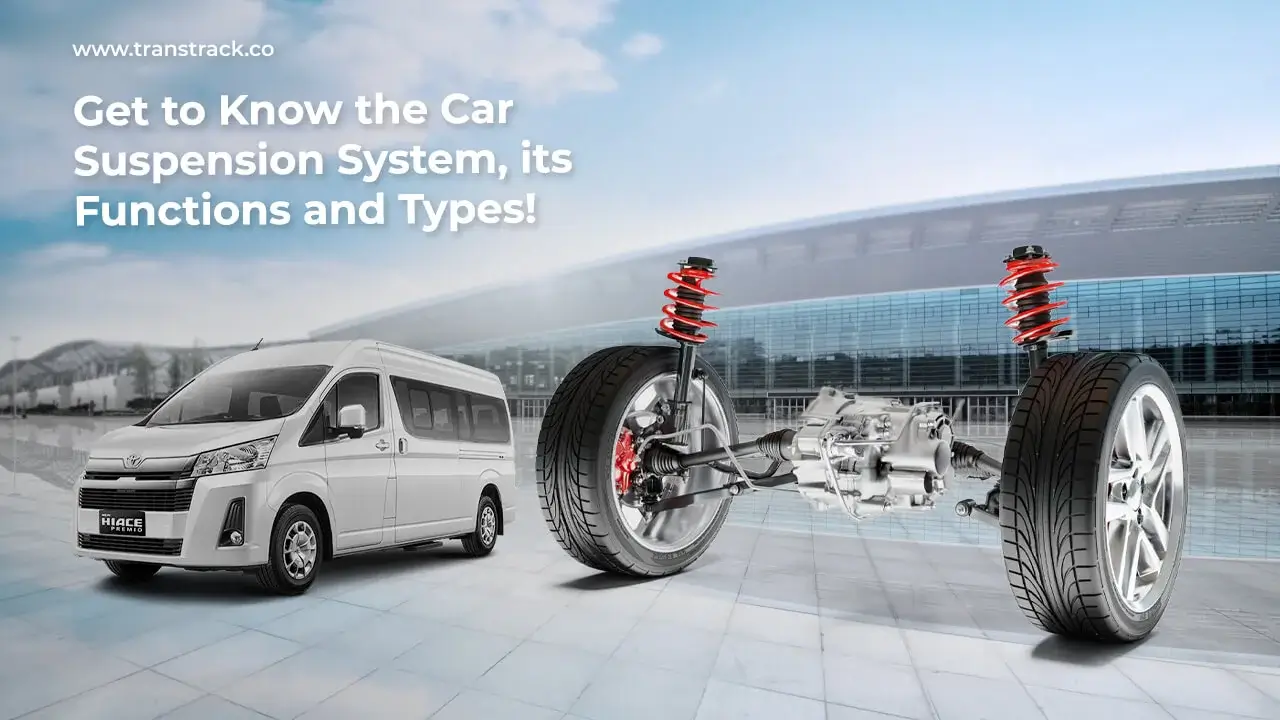Get to Know the Car Suspension System, its Functions and Types!

The suspension system is one of the vital components in a motorized vehicle. This system functions to absorb vibrations and shocks from the road surface, thereby increasing comfort and stability while driving.
Suspension system car is a collection of components that connect the wheels to the car body. This system is tasked with dampening vibrations from uneven road surfaces so that the driver and passengers feel comfortable. In addition, the suspension functions to provide stability to the car’s control when speeding, turning, or when passing uneven roads.
In this article TransTRACK has summarized information about this system to add to your knowledge. Let’s take a look!
Function of the Suspension System in a Car
The function of this system in a car has a very important role in maintaining the comfort, safety, and overall performance of the vehicle. The following is a detailed explanation of the main functions of this set of components in a car:
Absorbing Shock and Vibration
One of the main functions of this system is to absorb shock and vibration generated by uneven road surfaces. Without an effective system, the vehicle will experience significant shaking, making the ride uncomfortable and damaging vehicle components. The suspension is responsible for dampening and absorbing the energy generated by road unevenness, so that passengers do not feel or feel any unevenness.
Maintaining Vehicle Control and Stability
This system plays an important role in maintaining vehicle control and stability. When driving at high speeds or maneuvering, the suspension must be able to keep the wheels in contact with the road surface. This ensures that the vehicle remains stable and does not lose traction. Components such as springs and shock absorbers help regulate wheel movement and maintain full control of the vehicle.
Provides Driving Comfort
The ride comfort aspect is greatly affected by this system. Components such as per and springs are designed to provide flexibility and shock absorption, so that passengers do not feel every bump or unevenness in the road. A good suspension will make a significant difference in comfort during a ride, especially on poor road conditions.
Minimizes Tire and Other Component Wear
Suspension functions also include protection against tire and other component wear. By reducing the shock and vibration received by the wheels, the suspension helps to extend the service life of tires and components such as springs and shock absorbers. It also reduces the load on the steering and suspension systems, thereby reducing the risk of damage and component wear.
Types of Car Suspension Systems
There are several types of car suspension systems that are commonly used, and each type has its own characteristics. Here are some of the types of systems you need to know:
MacPherson Suspension System
The MacPherson Suspension System is one of the most common suspension designs used in most front-wheel vehicles. It combines the functions of a spring and shock absorber in a single unit known as a strut. The strut consists of a spiral spring and shock absorber tube attached together, allowing for a simpler and more compact design.
MacPherson suspension provides a good balance between comfort and handling, making it ideal for passenger cars. Its advantages include ease of assembly and lower manufacturing costs, however, for ultimate performance, an independent suspension system is often chosen.
Double Wishbone Suspension System
The Double Wishbone Suspension System, also known as double A-arm suspension, uses two “W” shaped arms on each wheel, which are connected to the vehicle frame and allow independent movement of the wheels. This design provides superior control over wheel movement, providing excellent handling capabilities and stability.
High-performance cars and racing vehicles often use Double Wishbone suspension for its ability to keep the wheels upright even under extreme driving conditions. Other advantages include high adjustability, giving drivers the flexibility to optimize suspension performance to their preference.
Torsion Beam Suspension System
The Torsion Beam Suspension System is a simpler and lighter design, often used in rear-wheel drive vehicles or in small to mid-size cars. It involves a U-shaped bar connected to the rear wheels and controlled by a spring.
Although simpler, it is able to provide a good balance between comfort and stability. Compact vehicles such as hatchbacks and sedans often use Torsion Beam suspension due to its production efficiency, and in some applications, it can provide satisfactory performance for everyday drivers.
Multi-Link Suspension System
The Multi-Link Suspension System is one of the most complex and advanced independent suspension designs. It uses a number of arms and links that are connected to each other and to the vehicle frame, providing a high degree of freedom of movement for each wheel.
Multi-Link suspensions are often used in luxury and high-performance cars for their ability to provide precise handling and optimal ride comfort. Although it is more complicated in its structure and production, the advantages in control, handling and response make it a highly valued choice in the automotive world.
It is important to remember that an understanding of a car’s suspension system is not only relevant for drivers, but also for vehicle owners. Proper care and maintenance of these systems can extend the life of the vehicle and reduce the risk of suspension-related problems.
For vehicle owners, the use of Vehicle Maintenance System is a smart move to ensure that the suspension system and other components remain in optimal condition. With this technology, vehicle maintenance becomes easier and more effective.
The VMS can monitor the condition of the suspension, collect data on performance, and provide early warnings if potential problems are detected. Thus, the use of this technology not only increases the life of suspension components, but also reduces the risk of damage and costly maintenance, thus providing optimal efficiency and reliability to the car’s suspension system. Interested in the benefits obtained from the Vehicle Maintenance System? Contact TransTRACK now and start doing effective and efficient car maintenance!
Topic





